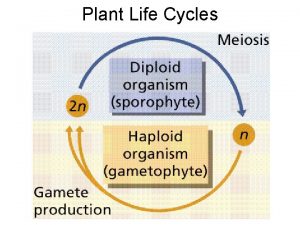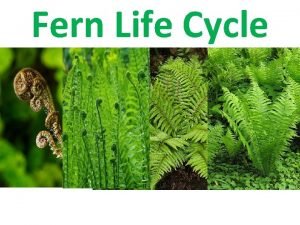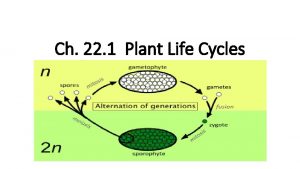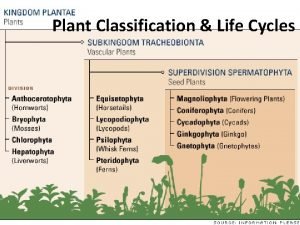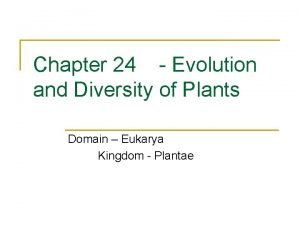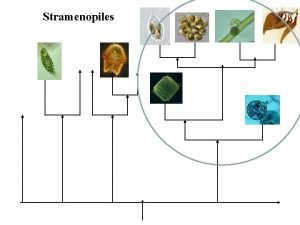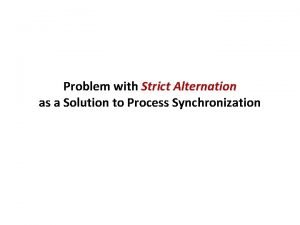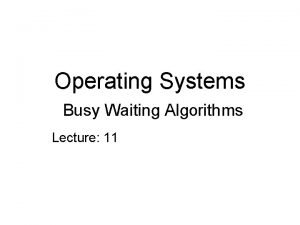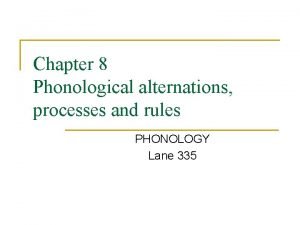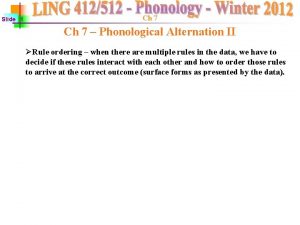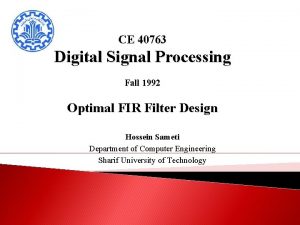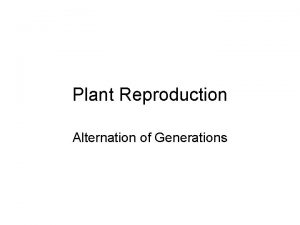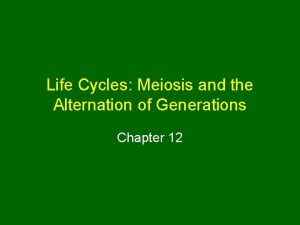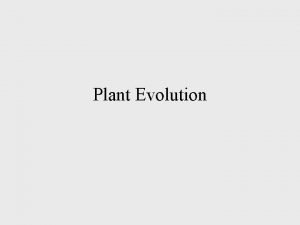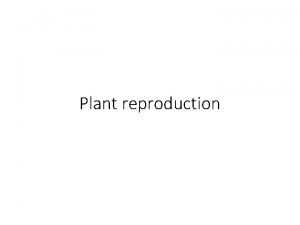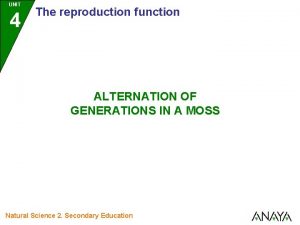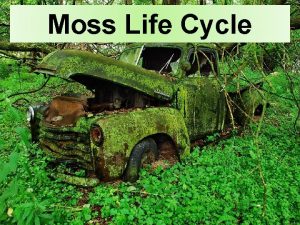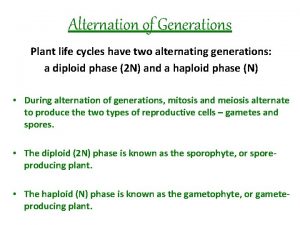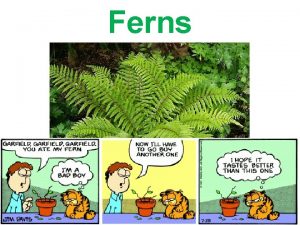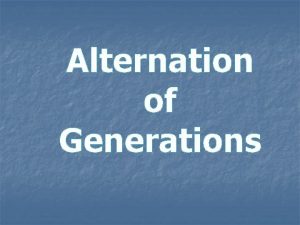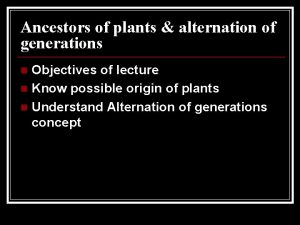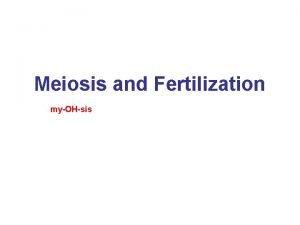Meiosis and Alternation of Generations Chapter 12 Outline





















- Slides: 21

Meiosis and Alternation of Generations Chapter 12

Outline v Introduction • Asexual • Sexual Reproduction v The Phases of Meiosis • Division II v Alternation of Generations

Introduction v v Asexual Reproduction - production of cells identical in chromosomes with cells from which they arose Sexual Reproduction - in nearly all plants • Results in formation of seeds in flowering and conebearing plants • Gametes produced − Egg and sperm unite to form zygote

Introduction Asexual and Sexual Reproduction

Introduction v Cells -> 2 sets of chromosomes, 1 set from each parent • Members of each chromosome pair identical in: − Length − Amount of DNA − Genes carried − Location of centromere • Homologous Chromosomes = chromosome pairs

Introduction v Results of meiosis: • 4 cells from 2 successive divisions − Cells with half chromosome # of parents − Each cell rarely identical to original cell or each other

The Phases of Meiosis v Before meiosis, DNA molecules of each chromosome double • Each chromosome has identical DNA molecules held together by centromere v Meiosis: • Division I (Meiosis I or Reduction Division) - # of chromosomes reduced to half • Division II (Meiosis II or Equational Division) - no further reduction in chromosome #

The Phases of Meiosis Division I v Prophase I • Chromosomes coil and condense, and align in homologous pairs • Nuclear envelope and nucleolus disassociate • Each closely associated pair of chromosomes exchange parts = crossing-over Chromosomes coil

The Phases of Meiosis Division I v Prophase I - Crossing-over • Chiasmata form • Results in exchange of DNA by 2 parents Chromosomes align in pairs; chiasmata visible

The Phases of Meiosis Division I v Metaphase I • Chromosomes align in pairs at equator • Spindle formation completed

The Phases of Meiosis Division I v Anaphase I • One whole chromosome from each pair migrates to pole v Telophase I • Original cell becomes 2 cells or 2 nuclei

The Phases of Meiosis v v Similar to mitosis Division II Prophase II • Chromosomes become shorter and thicker

The Phases of Meiosis v v Similar to mitosis Division II Metaphase II • Centromeres become aligned along equator • New spindles completed

The Phases of Meiosis v v Similar to mitosis Division II Anaphase II • Centromeres and chromatids of each chromosome separate, and migrate to opposite poles

The Phases of Meiosis Division II v Telophase II • Coils of chromatids relax and chromosomes become longer and thinner • Nuclear envelope and nucleoli reappear for each group of chromosomes • New cell walls form Chromosomes at poles Formation of cell walls

Alternation of Generations v v v Haploid (1 x) - cell with 1 set of chromosomes • Gametes Diploid (2 x) - cell with 2 sets of chromosomes • Zygote Polyploid - cell with >2 sets of chromosomes • Triploid (3 x) - 3 sets of chromosomes − Homologous chromosomes cannot pair properly, thus gametes typically inviable − Navel oranges, seedless watermelons • Tetraploid (4 x) - 4 sets of chromosomes − Potatoes, pasta wheat

Alternation of Generations v Alternation of Generations - life cycle involving sexual reproduction alternating between 2 n sporophyte phase and 1 n gametophyte phase • Sporophytes develop from zygotes and produce sporocytes − Sporocyte undergoes meiosis - produces 4 1 n spores

Alternation of Generations v v Gametophytes develop from spores • Form cells or sexual structures in which gametes are formed by mitosis Fertilization produces zygote • Fertilization (Syngamy) = fusion of gametes

Alternation of Generations v v First cell of gametophyte generation = spore, and last cell = gamete Any gametophyte cell = 1 n First cell of sporophyte generation = zygote, and last cell = sporocyte Any sporocyte cell = 2 n

Alternation of Generations v v Change from sporophyte to gametophyte generation occurs from meiosis Change from gametophyte to sporophyte occurs from fertilization

Review v Introduction • Asexual • Sexual Reproduction v The Phases of Meiosis • Division II v Alternation of Generations
 Plant life cycles and alternation of generations
Plant life cycles and alternation of generations Fern alternation of generations
Fern alternation of generations Alternation of generations in plants
Alternation of generations in plants Alternation of generations
Alternation of generations Alternation of generations
Alternation of generations Meiosis and genetic variation usatestprep
Meiosis and genetic variation usatestprep Chapter 10 meiosis 1 and meiosis 2
Chapter 10 meiosis 1 and meiosis 2 Chapter 10 section 1 meiosis
Chapter 10 section 1 meiosis Differences between mitosis and meiosis
Differences between mitosis and meiosis Disvantages of sexual reproduction
Disvantages of sexual reproduction Meiosis and mitosis
Meiosis and mitosis Metaphase 1
Metaphase 1 Quote one topic sentence
Quote one topic sentence What is isomorphic alternation of generation
What is isomorphic alternation of generation Strict alternation
Strict alternation What is busy waiting in os
What is busy waiting in os Alpha notation linguistics
Alpha notation linguistics Alternation in phonology
Alternation in phonology Alternation theorem in dsp
Alternation theorem in dsp Alteration or alternation
Alteration or alternation Coral life cycle
Coral life cycle Single character alternation in regexp
Single character alternation in regexp
